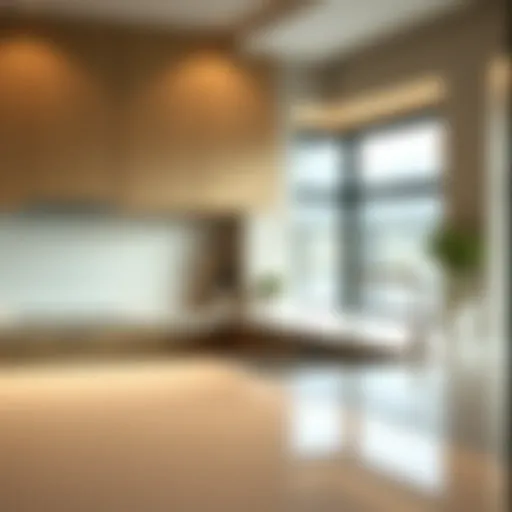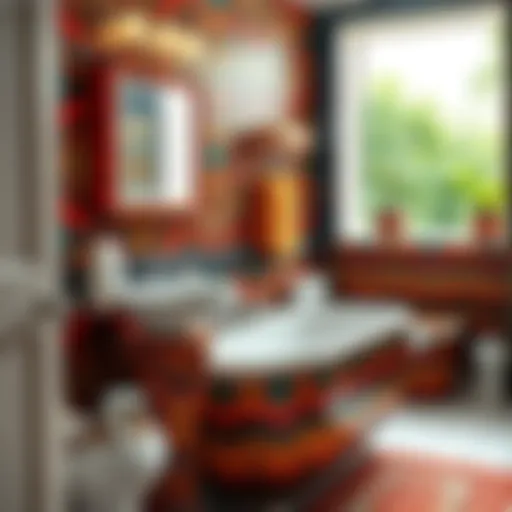Exploring Drop Leaf Pub Style Tables: Design and Trends

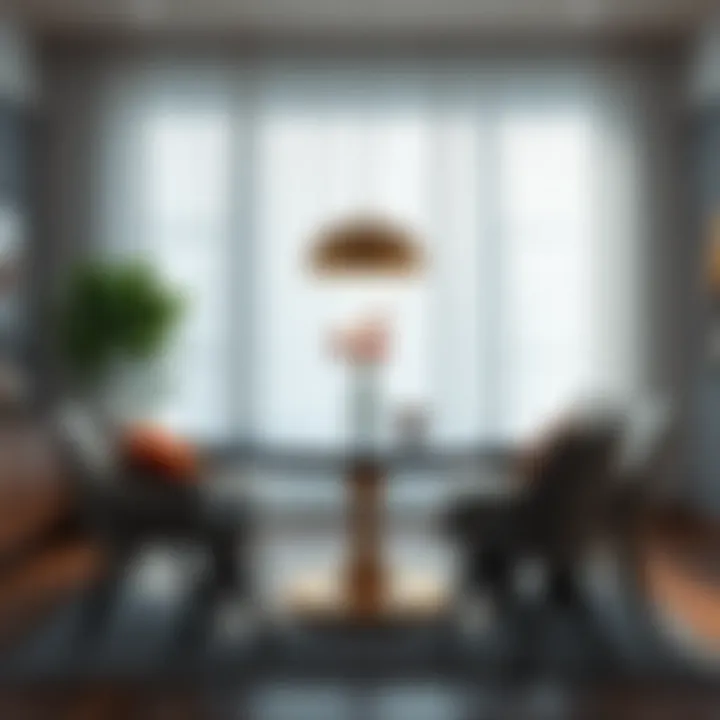
Intro
Drop leaf pub style tables have a charm that many other furniture pieces just can’t match. These tables exemplify a blend of functionality and aesthetic appeal, carving out their niche in homes where space is often at a premium. Their unique design allows them to adapt to different situations, making them a favored choice among homeowners, interior designers, and furniture aficionados. In this article, we will explore how these tables not only serve a practical purpose but also contribute to the overall style of a room.
In recent years, the focus has shifted to incorporating multifunctional furniture in homes. Drop leaf tables fit this trend perfectly, offering flexibility and space-saving capabilities. Whether in a cozy apartment or a sprawling house, these tables bring a sense of character and versatility. Their history and evolving designs reflect changes in lifestyle and preferences, hinting at their enduring popularity.
Let’s delve into the nuances of design and trends associated with these tables, and examine what makes them stand out.
Furniture Styles and Trends
Modern vs. Traditional: Understanding the Aesthetics
When considering drop leaf tables, one must navigate the interplay between modern and traditional designs. Modern interpretations focus on clean lines, minimalist aesthetics, and functionality. These tables are often made from materials like metal and glass, bringing a sleek, contemporary feel to spaces. On the other hand, traditional styles emphasize warmth and craftsmanship, utilizing solid woods such as oak or walnut, resulting in tables that exude charm and nostalgia. The choice largely depends on the design ethos of the home.
"The right table can seamlessly integrate into its environment, enhancing style and usage"
Making a Choice
With so many options available, choosing a drop leaf table can be majorly influenced by the overall décor of your space. Here are a few factors to consider:
- Color Consideration: A natural wood finish may suit a rustic aesthetic, while bold colors can elevate a modern interior.
- Shape Matters: Circular tables tend to create a casual vibe, while rectangular ones promote a more formal atmosphere.
- Versatility: Look for tables that can easily transition from a compact size for daily use to a larger setting for gatherings.
Color and Material Trends: What's In and What's Out
As we look towards the future, specific colors and materials emerge as key players in the world of furniture design. Here are some trends that have surfaced:
- Earthy Tones: Shades like terracotta, olive green, and mustard yellow are gaining traction, reflecting a desire to bring nature indoors.
- Sustainability: Eco-friendly materials such as reclaimed wood are not just preferable for environmental reasons; they add character and a story to each piece.
- Mixed Materials: Combining wood and metal or incorporating fabric in the designs is becoming increasingly popular, bridging gaps between different styles.
Homeowners and designers alike are finding ways to incorporate these trends while still valuing the functional benefits that drop leaf tables provide.
Furniture Care and Maintenance
With the right care, drop leaf tables can last for generations. Maintaining their appearance and functionality doesn’t require a miracle; a bit of dedication goes a long way.
Tips for Prolonging the Life of Your Furniture
- Regular Cleaning: Dust and grime can accumulate, particularly in the crevices; a dry cloth is often enough, but occasional use of wood polish can maintain the shine.
- Avoid Direct Sunlight: Positioning your table away from direct sunlight can prevent fading and warping.
- Use Coasters: To keep surfaces safe from rings and heat marks, coasters are essential.
DIY Repair Hacks for Common Furniture Issues
Even the sturdiest tables may face wear. Implementing simple DIY fixes can extend their life:
- Scratch Patch-Up: A wax crayon that matches the table's color can fill in small scratches.
- Stability Boost: If the table wobbles, check the hardware. Tightening screws can fix that annoyance in a jiffy.
- Refinishing: For more significant imperfections, consider sanding and refinishing the surface to renew its former glory.
For further reading on furniture maintenance, check out Wikipedia and Britannica.
History and Evolution of Drop Leaf Tables
The story of drop leaf tables is not just about furniture; it mirrors the changing lifestyles of those who use them. As living spaces evolved, so too did these ingeniously crafted tables. An understanding of their history helps us appreciate their design and functionality today, giving insight into why they remain relevant in modern homes.
Origins of the Drop Leaf Design
The roots of the drop leaf table can be traced back to the 17th century in England. It was a practical solution developed for small homes where every inch counted. The innovative mechanism allowed for the leaves to be raised and lowered, adapting to varying needs. Picture a family gathered for dinner; they would extend the table when company came and retract it when they didn't need the extra space. The concept was a stroke of genius, striking a balance between form and function. The ease of transforming an open table into a compact piece meant that these designs were ideally suited for both everyday use and special occasions.
As with most designs, the drop leaf table was influenced by the materials available at the time. Early versions were predominantly made of oak, prized for durability and aesthetic appeal. However, as new materials emerged, so did the versatility of design. The adaptability of this style propelled it through different eras; it saw transformations in shapes, styles, and materials, ensuring its place in early homes.
Transformation Through the Ages
The evolution of drop leaf tables took on many forms throughout history, reflecting the shifting trends and necessities of different times. In the 18th century, colonial America embraced the drop leaf design. They produced lighter tables, often combining wood types like cherry and maple, making it accessible to a broader audience. The utilitarian aspect flourished during the Industrial Revolution; standardization allowed for mass production, leading to various styles that catered to different tastes.
The 20th century marked a period of bold design changes. Mid-century modern enthusiasts embraced the drop leaf idea, bringing in a clean aesthetic, integrating new materials like laminated wood and metal. The looks were sleek and functional, appealing to a growing urban crowd. Nowadays, designers mix vintage elements with modern lines, creating striking pieces that stand out.
Key shifts in aesthetic preferences and lifestyle choices have marked the transition of drop leaf tables. Today, they are not merely a relic of the past; instead, they occupy a prominent place in contemporary home designs.
"The enduring utility of drop leaf tables is a testament to their ability to adapt to the ever-changing nature of home living and design."
Understanding this evolution is key to appreciating the drop leaf tables we see today, where they marry historical roots with modern functionality.
This transitional journey from necessity to an elegant component of home décor underscores their invaluable role in maximizing space while offering a touch of charm to interiors.
Understanding Pub Style Tables

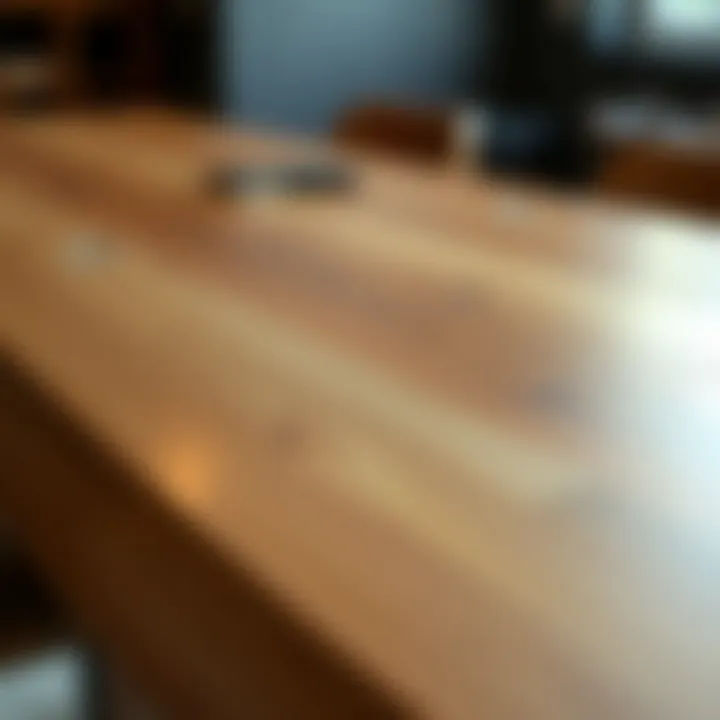
Pub style tables have long held a special place in both taverns and homes alike. More than just a piece of furniture, they embody a particular lifestyle that transcends mere function. Understanding these tables involves appreciating their historical context, the cultural traditions they represent, and their role in modern interior design. By diving into the essential elements of pub style tables, one can see how they blend character with practicality, making them an appealing choice for many.
Defining Features of Pub Style Tables
Pub style tables offer unique features that distinguish them from more conventional tables. Firstly, their height is generally taller than that of standard dining tables—often around 40 to 42 inches. This height is typically designed for bar stools, allowing for a casual dining experience conducive to entertaining and socializing.
Another notable aspect is their robust construction. Made from durable materials like solid wood or metal, these tables provide stability and longevity. A wooden tabletop, possibly finished with a rich stain or natural look, often serves as a cozy centerpiece, inviting gatherings of friends and family. The rich surface can add warmth to any room, especially when contrasted with cooler elements in decor.
Additionally, many pub tables feature a circular or square shape, promoting easy flow and conversation among users. This design allows for better accessibility, ensuring that everyone seated can engage in discussions without barriers.
Lastly, the more rustic designs showcase intricate carvings and a timeworn feel which align with the rich history of pub culture. Here are a few features that define pub style tables:
- Height: Tall, generally designed for bar seating.
- Materials: Durable wooden or metal constructions.
- Shape: Often circular or square for ease of conversation.
- Aesthetic: Rustic charm with intricate designs.
These features, combined, not only serve a functional purpose but also make a statement within home interiors, drawing upon the essence of social spaces.
The Cultural Significance of Pub Tables
Pub tables operate within a cultural context that goes beyond mere dining or drinking; they represent a gathering ground for community interaction and shared experiences. Originating from the taverns of old, they served as the setting for storytelling, celebrating, and, sometimes, even negotiating.
"A pub table is not just furniture; it's where friendships flourish, and memories are forged."
In today’s societies, these tables still play a pivotal role in fostering socialization. Be it within a home or a bar, they encourage people to come together, share meals, laugh, and make memories. The casual nature of pub style tables invites comfortable, unstructured conversations—far removed from the formality that traditional dining tables often impose.
This cultural essence can be further observed through the visual aesthetics that many of these tables carry. For example:
- Rustic Styles: Many pub tables embrace an old-world charm that whispers tales of history, drawing in users into a narrative carried by the furniture itself.
- Contemporary Designs: In contrast, modern interpretations may strip down the rustic feel, opting for sleek lines and minimalist elements while still retaining the inviting atmosphere.
- Community Gathering: Some models increasingly feature inclusivity in design, allowing for larger groups t gather comfortably, underscoring the very essence of community.
In summary, understanding pub style tables means recognizing their dual role as both furniture pieces and facilitators of culture. By appreciating these elements, one can see how they fit into both modern homes and more traditional settings.
Design Characteristics of Drop Leaf Pub Style Tables
The design characteristics of drop leaf pub style tables are essential to understand as they contribute significantly to both practicality and aesthetics within a living space. These tables are not mere furniture; they fulfill a dual role of functionality and style, catering to various needs of modern homeowners, especially those in tighter spaces. The ability of a table to adapt to its surroundings and needs is a key advantage, and this section highlights several elements that matter when choosing a drop leaf pub style table.
Material Choices
Wood Variants
When it comes to material choices, wood variants are a frontrunner in the realm of drop leaf pub style tables. Wood possesses a classic quality that resonates well with many households. Its warmth and natural grains offer an inviting atmosphere, progressively enhancing the appeal of the table. Popular types of wood like oak, maple, and walnut bring distinct characteristics to the table. For instance, oak's durability and resistance to wear make it a preferred choice for daily use.
However, while wood is often viewed as a beneficial option due to its sturdiness and timeless appeal, it does come with some drawbacks. It requires maintenance to keep its sheen and can warp in high moisture environments. Despite this, the charm of a well-crafted wood table can hardly be overstated. Homeowners often find that the charm of natural wood grain adds a layer of uniqueness that cannot be replicated in synthetic materials.
Metal and Composite Options
Aside from wood, metal and composite options are rising stars in the drop leaf table market. These materials are celebrated for their modern aesthetic and resilience. Metal tables, often featuring sleek lines and industrial styles, can serve as striking focal points in contemporary homes. The biggest advantage of these tables is their durability; metal is less likely to wear down than wood, making them a long-lasting choice.
On the flip side, some may find the coldness of metal less inviting compared to wood. Composite materials, which often include blends of wood fibers and plastics, come into play as a more cost-effective solution. Their versatility allows for creative designs and finishes, but quality can vary dramatically depending on production standards. Although they might lack the authenticity of solid wood, composite tables can still deliver an appealing aesthetic coupled with affordability.
Size and Shape Variations
Round vs. Rectangular
The size and shape of drop leaf tables can influence their suitability for different spaces and purposes. Round tables are often seen as friendly and inviting. They promote conversation and eliminate the harsh corners common in rectangular tables, making them a fantastic choice for smaller settings. Moreover, the absence of sharp edges makes them safer for homes with children.
Conversely, rectangular tables lend themselves better to a traditional dining experience. They accommodate more seats and can be more effective for larger gatherings. The choice between these shapes often boils down to personal preference and intended use. While round tables create a casual, cozy vibe, rectangular tables can convey a more formal atmosphere, suitable for dinner parties or game nights.
Standard vs. Custom Measurements
When pondering about standard versus custom measurements, one must consider the specific space available. Standard size tables are readily available and designed to fit a majority of spaces. They are often more cost-effective and easier to find. However, if a home has unique space constraints, opting for custom measurements could provide a tailored solution that not only fits perfectly but also maximizes the functionality of the space.
Custom measurements can offer the added benefit of unique design features that standard tables don’t include. Homeowners often find that custom tables can be designed to match both size needs and style preferences, although this route may take more time and often comes at a premium cost.
Finish and Aesthetic Options
Natural vs. Stained Finishes
Finish plays a crucial role in the overall aesthetic of drop leaf tables. Natural finishes showcase the raw beauty of the wood grain, offering an organic feel to any space. They require less maintenance and are typically more durable over the long haul. Homeowners looking for a rustic or vintage charm often find that natural finishes blend seamlessly with their existing decor.
On the other hand, stained finishes allow for more control over color and style, enabling a table to match specific color palettes in the home. Staining can enrich the beauty of the wood while also safeguarding it against moisture damage. However, these finishes might require more upkeep, as they can fade over time and might need periodic reapplication to maintain their beauty.
Paint and Upholstery Choices

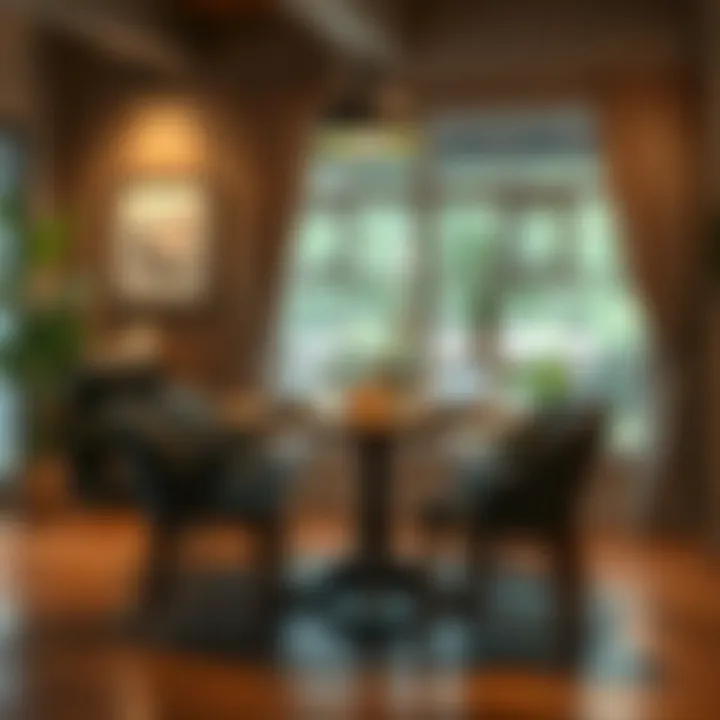
The choice of paint and upholstery for drop leaf tables brings in an element of personalization. Painted surfaces can inject a splash of color into a room, making the table a centerpiece that reflects the homeowner's style. For instance, bold colors can liven up a neutral room, while pastel hues can add a soft, calming effect.
Upholstered elements, often found in bar stools or chairs that accompany these tables, provide an extra layer of comfort and style. This option allows for also integrating contrasting textures to create visual interest. While such customizations elevate the design aspect, they can also present challenges in terms of cleanliness and durability, as upholstered fabrics may be prone to stains and wear, requiring more frequent maintenance than wooden surfaces.
"Choosing the right design characteristics for your drop leaf table can make all the difference in elevating your living space to one that is both functional and stylish."
Functional Aspects of Drop Leaf Tables
The functional aspects of drop leaf tables are no small potatoes. They offer a range of benefits that make them not just a pretty face in home décor, but also supremely practical. In a world where space is at a premium, particularly in urban settings, making the best use of every square inch can’t be overstated.
Space Maximization
Optimal Use in Small Spaces
When it comes to small living spaces, drop leaf tables truly shine. One standout characteristic of these tables is their ability to fold leaves down when not in use, creating a compact profile. This feature transforms an otherwise obstructive piece of furniture into a versatile tool for maximizing every inch of floor space. A kitchen corner, narrow dining area, or even a snug apartment can benefit immensely from a drop leaf design.
For instance, a drop leaf table can comfortably serve two for a weeknight dinner, but with just a swift motion, it opens up to accommodate more guests during special gatherings. This versatility means that homeowners don’t have to forgo social experiences due to limited space. One could say that it’s the Swiss Army knife of tables—compact when needed, but expansive when the occasion calls for it.
However, the table's stability when the leaves are extended can be a concern. It is crucial to ensure that the mechanism holding the leaves in place is strong. Otherwise, it might feel like playing a game of Jenga during your dinner party.
Adaptability for Larger Gatherings
The adaptability offered by drop leaf tables extends beyond small spaces; they also shine in accommodating larger gatherings. When the full potential of the table is unleashed—with both leaves up—you can fit everyone from family reunions to game nights without much hassle. This adaptability is a significant draw for people who often entertain. The straightforward transition between a small everyday table and a larger gathering piece is a luxury in disguise.
The unique feature here is the ability for easy setup and breakdown. Setting up for a dinner gathering is as simple as unfolding the leaves, while packing up is just as easy. This efficiency is rare in traditional table setups.
On the downside, not every model is built the same. Some drop leaf tables may struggle with structural rigidity when fully extended, leading to concerns about whether they can hold heavy dishes or enthusiastic board gamers. Keeping an eye on quality is essential to ensure that the adaptability doesn't come at the cost of stability.
Multifunctionality
Dining and Workspace Duality
In the era of remote work and flexible living arrangements, the dining and workspace duality of drop leaf tables deserves a spotlight. Homeowners can seamlessly transition between enjoying a meal and getting work done, making this type of table a very popular choice. The beauty lies in the multifunctional design; the same surface that hosts Sunday brunch can double as a makeshift office during your workweek.
The practical appeal here is clear; why own multiple tables when one can do the job of two? This not only saves space but also simplifies lifestyle choices, which is a win-win in any home. While it feels cozy to have a dining setup, spread out documents and a laptop on the same table isn’t a biggie since the surface area is versatile enough to accommodate both functionalities without feeling cramped.
However, care must be taken; a cluttered workspace can encroach on dining pleasures, leading to a less-than-ideal atmosphere during mealtimes. Finding a balance between these two uses can optimize enjoyment for both activities.
Additional Storage Solutions
Many drop leaf tables incorporate storage solutions that are invaluable, especially in smaller homes. Whether it’s built-in drawers or shelves located underneath the table, these features cater to the need for organization without compromising on aesthetics. You can stow away coasters, cutlery, or even craft supplies, keeping countertops clear and tidy.
The inclusion of storage options can dramatically increase the table's functionality while ensuring that everything is within reach when needed. An organized table is an inviting table, which is particularly appealing when hosting.
Yet, it’s important to note that not all tables come with these features. If you prioritize storage, make sure to thoroughly vet your options. A stylish yet cluttered tabletop will quickly turn the table from functional to frustrating.
"The functionality of drop leaf tables goes beyond aesthetics; they blend form and function in ways that cater to modern living."
In summary, the functional aspects of drop leaf pub style tables are both practical and adaptable, allowing them to fit into a variety of spaces and purposes. With their remarkable ability to optimize space, adapt for guests, serve as dual-purpose areas, and offer storage solutions, these tables are indeed a clever investment for various lifestyles.
Integrating Drop Leaf Tables into Interior Design
Integrating drop leaf tables into interior design is crucial for maximizing both aesthetics and functionality in living spaces. These tables not only serve as practical furniture pieces, but they also enhance the overall atmosphere of a room. The versatility of drop leaf tables allows them to adapt to various design styles and meet different spatial needs while providing comfort and style.
Complementing Existing écor
Rustic and Traditional Settings
Rustic or traditional settings embrace warmth and natural materials, making them a welcoming choice for many homeowners. Drop leaf tables in these environments often feature wood with rich textures and grains that can complement the overall organic vibe. A key characteristic of rustic design is its emphasis on handcrafted elements, which allows drop leaf tables to shine, especially when they show visible signs of craftsmanship.
For instance, a table made from reclaimed barn wood not only adds charm but also tells a story of sustainability and history. It becomes a focal point in the room, drawing attention not just for its utility but also for its beauty and character. However, one must be cautious about matching painted finishes and stains; the wrong color might clash with other natural elements in the space. But when chosen correctly, these tables provide a cozy, inviting atmosphere.
Modern and Minimalist Styles
In contrast, modern and minimalist styles lean towards simplicity and functionality, often utilizing clean lines and open spaces. Drop leaf tables fit neatly into these concepts through their ability to provide extra surface space without overwhelming a room. A pivotal aspect of modern design is the focus on functionality paired with subtle elegance; thus, a drop leaf table can serve many purposes while maintaining a streamlined look.
Many modern drop leaf tables come with sleek finishes, perhaps even in stark white or matte black, instantly providing a contemporary feel. They can be expanded or contracted as needed, making them ideal for dynamic living spaces where flexibility is important. However, there’s a downside—some may find these more contemporary designs lack the warmth and character found in traditional styles, focusing too much on function and too little on emotional connection.
Choosing the Right Table for Your Space
Choosing the right drop leaf table for your space encompasses several critical considerations, especially regarding color and fit within the room.


Consideration of Color Palettes
Color significantly impacts a room's ambiance; hence, the consideration of color palettes is fundamental when selecting a drop leaf table. Colors can evoke feelings, create focal points, and even influence how large or small a space feels. A well-chosen color can seamlessly blend or starkly contrast with existing décor, depending on the desired effect.
For example, soft, neutral tones can create a calm and balanced environment, while vibrant colors might energize the room and provoke conversation. Selecting the ideal color ensures that the table not only functions well, but also enhances the visual cohesion within the design. However, be wary— too bold a choice may dominate rather than complement the overall look.
Measuring Your Available Space
Measuring your available space is a straightforward yet often overlooked step that can make or break the successful integration of a drop leaf table. Accurate measurements allow you to assess what size and shape of table will best fit the home’s layout. This consideration directly influences how functional the table will be in daily life.
Knowing your space means you can find a balance between aesthetics and practicality. For instance, if you have an open-plan design, a round drop leaf table may enhance fluidity while allowing movement in tight areas, whereas a rectangular table may serve better in dining areas that need to accommodate larger gatherings. However, ignoring this practical aspect may lead to overcrowded or awkwardly laid-out rooms, detracting from the very benefits these tables are meant to provide.
Integrating drop leaf tables into your living spaces is more than just furniture arrangement; it’s an opportunity to enhance both style and functionality, making your home more hospitable and enjoyable.
Contemporary Trends in Drop Leaf Pub Tables
As home spaces evolve, so do the furniture pieces that graces them, and drop leaf pub tables are no exception. Today, these tables blend not only style with function, but also respond to changing consumer values and lifestyles. The importance of examining contemporary trends in these tables lies in their capacity to adjust to modern aesthetics and functionalities. It's not just about having a place to rest your drink; it’s about incorporating practical and stylish elements into living spaces that reflect personal taste while enhancing usability.
Eco-Friendly Materials
One of the standout trends in recent years is the rising demand for eco-friendly materials. This shift is more than a fleeting fad, it’s a commitment to sustainability that influences many homeowners today. With a growing awareness about environmental issues, more individuals prefer furniture made from renewable resources or recycled materials.
When it comes to drop leaf tables, you might notice options crafted from reclaimed wood, bamboo, or even recycled metals. These materials not only reduce the carbon footprint associated with furniture production, but also add a unique touch. Each piece carries a story, a history that can spark conversation. For instance, a table made from reclaimed barn wood brings rustic charm along with a sense of history that modern finishes often lack.
- Bamboo: It's a top contender due to its rapid growth rate. Resistant to pests and drought, bamboo has emerged as a superb alternative to traditional hardwoods.
- Reclaimed Wood: This trend emphasizes utilizing old structures, contributing to reduced waste. The knots and imperfections of reclaimed wood lend character, making every drop leaf table a unique piece.
- Recycled Metals: These can provide a durable and industrial flair, appealing to those who appreciate a modern aesthetic while being eco-conscious.
"Sustainability isn’t just a trend—it’s a lifestyle choice that reflects growing consumer values around environmental conservation."
Smart Features and Technology Integration
With technology being woven into the fabric of daily life, it comes as no surprise that smart features are finding their place in furniture design. Drop leaf tables are now being enhanced with technology that can elevate the user experience, pushing the boundaries of traditional functionality.
Imagine a drop leaf table not just serving as a surface for dining or work, but also featuring integrated power outlets or wireless charging stations. Such integrations cater to the tech-savvy consumer who values the convenience of keeping devices charged while they socialize or work from home. Furthermore, smart tables may include features like built-in speakers or Bluetooth connectivity, turning these simple tables into multifunctional hubs for entertainment and work.
- Integrated Charging Stations: Maintaining a charge is essential in today’s digital age. Having USB ports or wireless charging pads directly on the furniture makes life easier.
- Interactive Surfaces: Through technology, some designs allow for touchscreen capabilities, which can serve various applications from gaming to presentations, offering yet another layer of versatility.
- Smart Materials: Some drop leaf tables come with self-lifting leaves or adjustable heights, changing not just shape but function seamlessly.
As these trends take root, drop leaf pub style tables are poised to remain relevant, seamlessly adapting to the needs of modern living while retaining their timeless charm. Homeowners, designers, and enthusiasts alike have plenty of choices that cater to both aesthetic preferences and practical necessities in today's diverse marketplace.
Care and Maintenance of Drop Leaf Pub Style Tables
Taking care of your drop leaf pub style table is not just about preserving its aesthetic appeal; it’s also about sustaining its functionality throughout the years. With their unique folding design, these tables provide flexibility in use and can be a focal point in your living or dining spaces. Consequently, understanding how to maintain and care for them ensures their longevity and enhances your overall home experience.
A well-cared table tells a story of both nostalgia and practical use. Knowing the right cleaning methods and preservation strategies will help you keep your table looking as good as new, or even better, as it ages gracefully.
Cleaning Tips for Different Finishes
Different finishes on drop leaf tables require tailored approaches to cleaning. Various materials can add unique beauty, but they are not all created equal when it comes to maintenance.
- Wood Finishes: For tables with wood finishes, dusting with a soft, dry cloth is usually sufficient. If there are stains or grime, a damp cloth with mild soap can help. Avoid using too much water since moisture can warp the wood. After wiping, make sure to dry it off well. Refraining from abrasive cleaners will also prolong the finish.
- Stained Finish: If you have a table that has a stained finish, avoid any harsh chemicals or abrasive scrubbers. Instead, use a mixture of vinegar and water, approximately one part vinegar to four parts water. This helps in cleaning while maintaining the sheen. Following up with a light application of wood oil will keep it nourished.
- Painted Surfaces: For tables coated in paint, a gentle cleaner mixed with water can remove light dirt. It’s pivotal to use a soft sponge rather than a cloth to avoid scratching the surface. If a repaint is needed later, ensure the current paint surface is clean and smooth before applying new layers.
- Metal or Composite Finishes: For tables made from metal or composite materials, use a gentle dish soap and water solution with a microfiber cloth. Drying immediately is key, as any water left on metal can promote rust, especially if it’s in a humid environment. Make sure to avoid acidic or caustic cleaners that can discolor or damage the surface.
Long-Term Preservation Strategies
Long-term maintenance involves more than just cleaning and requires a proactive approach to preserve both the structure and design of your drop leaf table.
- Avoid Direct Sunlight: Prolonged exposure to sunlight can cause discoloration or fading of the finish. If your space is sunlit, consider using curtains or UV-filtering treatments on windows.
- Temperature Control: Fluctuations in temperature and humidity can affect wooden tables dramatically. Ideally, your table should be kept in a climate-controlled environment. Avoid placing it near radiators, air conditioning vents, or direct drafts as these extremes can warp the wood.
- Use Coasters and Place Mats: A simple yet effective way to prevent scratches and heat damage is by using coasters under glasses and placemats when serving meals. Expanding beyond mere aesthetics, these small changes can significantly extend the lifespan of your table.
- Regular Checks and Touch-Ups: Periodically check for loose hinges or joints, especially on the drop leaf mechanisms. If you notice anything amiss, address it before it leads to bigger problems. Likewise, applying quality wood polish occasionally safeguards the surface while providing a fresh look.
- Protective Covers: Lastly, if you’re not using your table frequently, consider investing in a protective cover. A fitted cover can prevent dust build-up and guard against accidental scratches.
"The right care today can lead to beautiful tales of gathering and meals shared, forever etched in the wood of tomorrow."
End
The world of drop leaf pub style tables offers a unique blend of design aesthetics and practicality. This article has journeyed through the historical significance, functional benefits, and current trends surrounding these versatile pieces. Embracing the characteristics of drop leaf tables can transform not just how we utilize space, but also how we perceive it.
Recap of Key Insights
In synthesizing the information presented, several key insights emerge about drop leaf pub tables:
- Versatility: Their ability to adapt to different space requirements makes them ideal for both small apartments and larger homes.
- Design Flexibility: Available in a multitude of styles and materials, they can seamlessly fit into nearly any decor scheme, from rustic to contemporary.
- Functional Innovation: They not only serve as dining surfaces but also contribute to efficient workspace solutions, highlighting their multifaceted utility.
- Sustainable Practices: With a growing trend towards eco-friendly materials, many manufacturers are embracing sustainable methods which reflects a societal shift towards responsible consumption.
By understanding these aspects, homeowners and interior design enthusiasts can make informed decisions that enhance their living spaces. Consider these insights as a roadmap to the ideal integration of drop leaf pub tables into diverse environments.
The Timeless Appeal of Drop Leaf Tables
Drop leaf tables are not just functional items but are pieces that hold a profound charm, capturing the essence of community and togetherness. Their design fosters engagement, allowing family and friends to gather comfortably, regardless of the size of the group. They are reminiscent of gatherings in cozy pubs or bustling kitchens, where stories and meals are shared freely.
Beyond nostalgia, the enduring practicality of their design ensures that they remain relevant in modern homes. With considerations around space efficiency and style, they embody a marriage of old-world charm with contemporary needs. Whether it’s a quick morning coffee or an elaborate dinner, drop leaf pub tables stand ready to accommodate.
Their timeless appeal lies in their adaptability – a quality highly prized in today's fast-paced world. From a simple addition of leaves to transform from intimate dining to hosting a larger group, these tables prove crucial in creating flexible living spaces. Ultimately, the enduring designs of drop leaf pub style tables are more than just functional furniture; they encapsulate a lifestyle centered on versatility and unity.



